Athanasius the Great summed up the connection between the Incarnation and our salvation in the famous line: God became human, so that we might become god. The doctrine of theosis (deification) sums up the Orthodox understanding of salvation in Christ. It is also the source of friction between Reformed and Orthodox Christians. In this blog posting I will show how the Orthodox understanding of theosis is grounded in Scripture and affirmed in the teachings of the early Church Fathers. In light of the controversial nature of theosis I will be highlighting the Orthodox understanding of theosis through the comparing of paradigm differences between Orthodoxy and the Reformed tradition. I close with a discussion of the practical consequences of the paradigmatic differences.
2 Peter 1:3-4
Many Protestants find the doctrine of theosis dubious despite the fact it is found in Scripture. We read in 2 Peter 1:3-4:
His divine power has given us everything we need for life and godliness through our knowledge of him who called us by his own glory and goodness. Through these he has given us his very great and precious promises, so that through them you may participate in the divine nature and escape the corruption in the world caused by evil desires. (NIV)
This does not mean we participate in God’s essence (ousia). Rather we are transformed into the likeness of Christ through participation in his grace, i.e., divine energies. The footnote commentary in the Orthodox Study Bible for 2 Peter 1:4 reads:
This [Theosis] does not mean we become divine by nature. If we participated in God’s essence, the distinction between God and man would be abolished. What this does mean is that we participate in God’s energy, described by a number of terms in scripture, such as glory, life, love, virtue, and power. We are to become like God by his grace and truly His adopted children, but never becoming God by nature.
The phrase “participate in the divine nature” (NIV) or “partakers of the divine nature” (KJV, OSB) is a translation of: “γένησθε θείας κοινωνοὶ φύσεως.” [Greek NT] The Greek for “participate” or “share” is κοινωνος (koinonos) which has a range of meanings. It has been used with reference to sharing in glory (1 Peter 5:1), sharing in Christ’s suffering (Philippians 3:10), and fellowship in the Holy Spirit (Philippians 2:1). It can have a spiritual/sacramental sense. Participation in a religious service, Christian or otherwise, has definite spiritual consequences. Participation in a pagan sacrifice results in participation with demonic forces (1 Corinthians 10:20) and likewise participation in the Eucharist results in participation in Christ’s body and blood (1 Corinthians 10:16). The emphasis here is on participation, transformation, and experiential change, rather than a judicial declaration of legal status. This distinction is central to the different attitude Orthodox and the Reformed have toward the fullness of salvation in Christ.
Koinonos can connote a sharing in similar circumstances, e.g., “just as you share in our sufferings, so also you share in our comfort” (2 Corinthians 1:7). The word can have relational connotations, e.g. “you became companions of those who were so used” (Hebrews 10:33; KJV); “if you consider me a partner” (Philemon 17; NIV).
The other key word in 2 Peter 1:4 is φυσις (physis). It can mean biological descent/nature: “we who are Jews by nature” (Galatians 2:13; KJV) or spiritual condition: “by nature children of wrath” (Ephesians 2:3; KJV). Paul in Romans uses the word physis in some rather interesting ways. In Romans chapter 2 he points out that there are Gentiles who are “not circumcised physically” (Romans 2:27; NIV) but who “do by nature things required by the law” (Romans 2:14; NIV). The expectation here is that both the outward and inward natures would complement the other. In other words our inner spiritual life ought to be expressed in our outward actions. So likewise our actions should flow from our inner life. And just as significant is the possibility that one’s nature can change, be transformed. In Romans 1:26-27 Paul wrote about “natural desires” (NIV) being “exchanged” (NIV) for unnatural ones. Just as sin results in the alteration of human nature so likewise salvation in Christ calls for a reverse alteration in human nature (cf. Romans 12:2).
While the original Greek koinonos (partaker) has a broad range of meanings, it is restricted by physis (nature). The relational and circumstantial meanings are excluded leaving either sacramental or biological meanings as the most likely options.
The Biblical Basis for Theosis
The biblical basis for theosis begins with the creation account in Genesis. Theosis is implicit in the doctrine of the imago dei: humanity being made in the divine image.
Let us make man in our image, in our likeness, and let them rule over the fish of the sea and the birds of the air, over the livestock, over all the earth, and over all the creatures that move along the ground. (Genesis 1:26; NIV)
The divine likeness implies our calling to be in communion with God, this makes man unique to the rest of Creation. This goes beyond the legal model which focuses more on our external legal or judicial status and good moral behavior – rather than the transformation of our inner nature. As a result of Adam and Eve’s sin the image of God has become marred in us. In the Incarnation God came to restore the imago dei. Salvation as theosis is based on the restoration of the image of God in us which in turn calls for the restoration of communion with God resulting in a change in human nature, i.e., ontological consequences.
The Apostle Paul in 2 Corinthians describes the Christian life as one of progressive transformation.
And we, who with unveiled faces all reflect the Lord’s glory, are being transformed into this likeness (image) with ever-increasing glory, which comes from the Lord, who is the Spirit. (2 Corinthians 3:18; NIV)
The reference to the visible transformation of Moses’ appearance in 2 Corinthians 3:13 points to an ontological transformation, not just behavioral and attitudinal changes.
Theosis also has eschatological implications; we find in the Apostle John’s first epistle:
Dear friends, now we are children of God, and what we will be has not yet been made known. But we know that when he appears, we shall be like him, for we shall see him as he is. (1 John 3:2-3; NIV; emphasis added)
Theosis finds its culmination in our entering into the life of the Trinity. In John 17 we read:
I have given them the glory that you gave me, that they may be one as we are one. I in them and you in me. May they be brought to complete unity . . . . (John 17:22-23; NIV)
As Christians we are called to be more than good people or even glorified beings like angels, we are called into the fellowship of love that is the Trinity. Thus, the Orthodox understanding of salvation is profoundly Trinitarian in implication.
In Scripture there are several accounts of theosis taking place. Theosis is implied in the account of Jesus walking on water in Matthew 14. Jesus’ walking on water was a sign of his divinity. Just as Jesus walked on water so did Peter implying Peter’s sharing in Jesus’ divinity. Note that Peter did not ask Jesus to grant him the ability to walk on water but that he be allowed to be with Jesus: “Lord, if it’s you tell me to come to you on the water.” (Matthew 14:28; NIV) This is the goal of theosis: union with Christ. Notice also that Peter was able to walk on water so long as he kept his eyes on Jesus, but the moment he became distracted and fearful he began to sink. Jesus reached out his hand and grabbed hold of Peter; this is a sign of God’s grace to us.
Theosis is also found in the Gospel accounts of the Transfiguration where the transfigured Christ speaks to the Old Testament saints Moses and Elijah. In Luke’s account we read that Moses and Elijah “appeared in glorious splendor” and that they talked to Jesus about his impending death (9:31). What happened was that the glory that Jesus had with the Father before the world began (John 17:5) was made manifest to his followers. Jesus’ glory is intrinsic to his nature. This glory attests to Jesus’ divinity. Just as striking is the fact that Moses and Elijah were also clothed in glory. This point to their having been transfigured into glorified beings by God’s grace. Their conversing with Christ points to their having acquired divine wisdom as to God’s will. The contrast between the two Old Testament saints standing up and the three disciples on the ground sleeping shows the progressive nature of Christian discipleship. Right now we are bumbling, fumbling followers of Christ but one day we will reach the state of enlightenment like that of Moses and Elijah. Sainthood is not for the fortunate few but for all Christians. The Orthodox approach to spiritual pedagogy is old school; the bar is set high and those who attain perfection are given due recognition. Orthodox spirituality is not like modern education where you win the prize just for being there. The term “saint” has a real meaning in Orthodoxy when it comes to spiritual advancement.
The Witness of the Church Fathers
In the early fourth century there took place a fierce controversy over whether or not Jesus was truly divine. For the early Christians this was not an abstract doctrinal dispute but one of immense consequence for our salvation. A Protestant would explain the necessity of Christ’s divinity in terms of his bearing the sins of the world. Such an argument is congruent with the penal substitutionary atonement theory but this is not the line of argumentation used by the early church fathers. Instead we read in Athanasius the Great’s On the Incarnation the reason for the Incarnation:
For He was made man that we might be made God; and He manifested Himself by a body that we might receive the idea of the unseen Father; and He endured the insolence of men that we might inherit immortality. (§54; emphasis added)
This was not a novelty by Athanasius. One of the earliest witnesses to theosis is Irenaeus of Lyons in Against Heresies.
. . . our Lord Jesus Christ, who did, through His transcendent love, become what we are, that He might bring us to be even what He is Himself. (AH 5 Preface; emphasis added)
Augustine on Theosis
The early church fathers took care to emphasize that deification is not intrinsic to human nature but a consequence of God’s mercy. Augustine of Hippo makes the critical point that we are deified by grace and not by nature.
See in the same Psalm those to whom he says, “I have said, You are gods, and children of the Highest all; but you shall die like men, and fall like one of the princes.” It is evident then, that He has called men gods, that are deified of His Grace, not born of His Substance. For He does justify, who is just through His own self, and not of another; and He does deify who is God through Himself, not by the partaking of another. But He that justifies does Himself deify, in that by justifying He does make sons of God. “For He has given them power to become the sons of God.” John 1:12 If we have been made sons of God, we have also been made gods: but this is the effect of Grace adopting, not of nature generating. (Augustine Exposition on Psalm 50)
Protestant Mistranslation
Given the catholicity of the doctrine of theosis among the early church fathers, it is puzzling that Protestants would be so reluctant to embrace it.
This bias is so strong as to create a blind spot among its leading patristic scholars. Take for example Gregory Nazianzen’s Oration I in which he asserted:
Let us become like Christ, since Christ became like us. Let us become gods for his sake, since he for our sake became man.
The Nicene and Post-Nicene Fathers (NPNF) series contains a serious mistranslation of the same passage. It reads:
Let us become like Christ, since Christ became like us. Let us become God’s for His sake, since He or ours became Man. (NPNF Second Series Vol. VII, p. 203)
The Greek text in Migne’s Patrologia Graecae Vol. 35 “Oration I – In Sanctum Pascha” (Section 17, p. 358) reads:
“γενωμεθα θεοι δι’ αυτον” (let us become gods for his sake).
It appears that the translators for the NPNF Church Fathers series mistranslated the text due to their Protestant biases! It is surprising and disheartening that there is no footnote offering an alternative reading. Caveat lector!
This leads to the question: Why is the doctrine of theosis so little known among Western Christians? And when they do learn about theosis why are Protestants often hostile to the doctrine of theosis? My suspicion is that what is at work here are differences in theological paradigms.
I. What’s Your Paradigm?
Creator-Creature Distinction
Paradigms provide the framework by which we organize data and exclude data. Because they frame the way we see reality, paradigms are often invisible to us. Because paradigms are not as explicit as doctrine, it takes a bit of detective work to discern the philosophical assumptions that shape a theological tradition.
The Creator-creature distinction that runs through Reformed theology has shaped its theory of knowledge (epistemology) as well as its theory of salvation (soteriology) and its understanding of the Christian life (spiritual formation). Karl Barth in his struggle against Liberalism and natural theology stressed the “infinite qualitative distinction” between the human the divine. It also forms the basis for the Reformed tradition’s radical understanding of grace in salvation, and in absolute categories where man can in no way contribute to his salvation; it is all divine grace. This leads to the principle of monergism which in turn leads to double predestination, that is, God alone determines who will be saved and who will be damned.
This Creator-creature distinction has become more explicit in recent theological discussions on the Internet. Derek Rishmawy in a 2012 blog article wrote:
So, the idea is that because there is a radical gap in reality between God and ourselves–he is necessary, infinite, transcendent, etc. and we are contingent, finite, bound–there is also a radical gap in our knowledge. In the same way that God’s reality is at a higher level than ours and sustains ours, the same is true of our knowledge. (Emphasis added.)
Reformed apologist Michael Horton affirmed the Creator-creature distinction in his criticism of the God of the gaps apologetic strategy:
Accordingly, to the extent that a certain state of affairs can be attributed to natural (human or nonhuman) causes, God is not involved. Again we meet the troubling univocity of being, which fails to recognize the Creator-creature distinction and the analogical character of creation in its relationship to God. (The Christian Faith, p. 338; emphasis added.)
Closer to the topic of theosis is Reformed pastor Steven Wedgeworth’s blog article: “Reforming Deification.” In it Wedgeworth expressed in colorful language his concerns about theosis.
The doctrine of deification (or theosis) is one of those doctrines that, in the words of one esteemed divine, “gives us the willies.”
He continues a little further:
The dangers of the wrong-kind of deification theology should be obvious. Collapsing the Creator-creature distinction, or even just smudging it a little, is seriously bad juju.
The Reformed emphasis on the Creator-creature can be overstated at times. While the Bible does teach the Creator-creature distinction, it also situates humanity at the crux of the Creator-cosmos nexus. In Genesis God climaxes creation with the making of man in his image and conferring on humanity lordship over creation. The Creator-creature paradigm takes an interesting new direction with the Incarnation. The Creator God comes down from heaven and becomes a creature. The Infinite becomes finite. The invisible becomes visible. The intangible becomes tangible. The Eternal enters into history.

“The Unsleeping Eye” Source
The uncontainable Word becomes confined in the Virgin’s womb. The one who made the Milky Way galaxy becomes a babe who suckles at the Theotokos’ breast. The Immortal God dies on the Cross for our salvation.
Mankind doomed to nothingness is rescued by Christ’s dying on the Cross, his third day Resurrection, and his Ascension. Then in the mystery of Pentecost Jesus we are given the Third Person of the Trinity, the Holy Spirit.
Did Calvin Follow the Church Fathers on Theosis?
The doctrine of theosis challenges the Reformed theological paradigm because of its explicit endorsement in 2 Peter 1:3-4. This leads to two questions: (1) How did Calvin understand 2 Peter 1:3-4? and (2) Did Calvin in fact believe in theosis? When we look at Institutes 3.25.10 we find something quite close to the Orthodox doctrine of theosis. The only difference is that Calvin seems to understand the conferring of divine glory, power, and righteousness as future events that accompany the resurrection, not as blessings for the current age. Calvin writes:
Indeed, Peter declares that believers are called in this to become partakers of the divine nature [II Peter 1:4]. How is this? Because “he will be . . . glorified in all his saints, and will be marveled at in all who have believed” [II Thess. 1:10]. If the Lord will share his glory, power, and righteousness with the elect—nay, will give himself to be enjoyed by them and, what is more excellent, will somehow make them to become one with himself, let us remember that every sort of happiness is included under this benefit. (Institutes 3.25.10)
Did Calvin affirm theosis? Consider the following:
Let us then mark, that the end of the gospel is, to render us eventually conformable to God, and, if we may so speak, to deify us. (Commentary 2 Peter 1:4)
But as we read on we find Calvin qualifying his earlier statement:
But the word nature is not here essence but quality. The Manicheans formerly dreamt that we are a part of God, and that, after having run the race of life we shall at length revert to our original. There are also at this day fanatics who imagine that we thus pass over into the nature of God, so that his swallows up our nature. (Commentary 2 Peter 1:4)
Thus, Calvin’s concern that theosis not be understood as our sharing in God’s essence is identical to Orthodoxy’s.
So, what did theosis mean for Calvin? He writes:
They [the Apostles] only intended to say that when divested of all the vices of the flesh, we shall be partakers of divine and blessed immortality and glory, so as to be as it were one with God as far as our capacities will allow. (Commentary 2 Peter)
For Calvin theosis consists of our “reverting to our original” state, that is, a return to Adam’s original pre-Fall condition. It appears that Calvin did not give much thought to the possibility that our union with Christ the Second Adam may result in something rather different. In other words, Calvin underestimated the significance of the Incarnation for our salvation. Morna Hooker writes:
If Christ has become what we are in order that we might become what he is, then those things which governed and characterized the old life of alienation from God in Adam no longer apply. It is the old man, i.e. the Adamic existence, which is crucified with Christ, Rom. 6.6 . . . [St. Paul] writes continually to his converts – Be what you are! Man has been recreated, called to be ‘holy’ – he should believe it and behave accordingly. (In Fr. Ted’s blog)
Calvin assumes that theosis is accomplished through a process of the removing of the “vices of the flesh.” This is consistent with the moral or juridical understanding of salvation but to share in immortality and divine glory has ontological implications that Calvin seems reticent to pursue. Prof. J. Todd Billings in a 2005 Harvard Theological Review article examined Calvin’s understanding of deification and found that although Calvin interacted with the early church fathers his understanding of deification is “distinctive” (p. 334). Rather than follow in the hermeneutical tradition of the early church fathers, Calvin here is venturing off in his own direction with a new interpretation. In time this would give rise to a new form of spirituality.
II. What’s Your Paradigm?
Sanctification = Theosis?
Is theosis another name for sanctification? The Protestant doctrine of sanctification does bear a certain resemblance to Orthodoxy’s theosis. Both involve the healing of the effects of sin, are progressive in nature, and culminate at the Second Coming. Another important similarity is that both are the result of the Holy Spirit in the Christian. But there are significant paradigm differences beneath the surface.
The Orthodox understanding of theosis is based on a sacramental worldview in which matter is viewed as capable of conveying divine grace. In this worldview the possibility is there for human beings to become channels of divine grace. As we grow in holiness, as our hearts become cleansed of the passions the life of God pervades our whole being with spillover effects. In contrast, Protestantism understands sanctification as moral transformation or an attitudinal change that leads to behavioral change. This is congruent with its dominant legal approach to salvation. Protestantism not only suspicious of, it implicitly denies the ontological transformation foundational to the Orthodox understanding on theosis.
But the question I have for my Protestant friends is this: Does your understanding of sanctification also allow for ontological transformation? When one reads the history of Protestantism one has to wonder: Where are the saints? Where are the believers whose lives are marked by extraordinary sanctity, steeped in prayer, and transfigured by the Divine Light that shone at Mount Tabor? The prominent personalities in Protestant history tend to be theologians known for their theological insights, e.g., Martin Luther, John Calvin, Ulrich Zwingli, John Wesley, Charles Hodge, Jonathan Edwards, or Karl Barth. Or for their preaching ministries, e.g., George Whitefield, Billy Sunday, Charles Spurgeon, D.L. Moody, Billy Graham; or missionaries, e.g., Hiram Bingham, Adoniram Judson, Samuel Zwemer, Jim Elliot, etc. Implicit in the culture of Protestantism is the priority on theology, preaching, and evangelism, and the downplaying of lives transformed through prayer and ascesis.
When one reads the history of Orthodoxy one comes across the lives of the saints: Anthony the Great, Mary of Egypt, Seraphim of Sarov, John of Kronstadt, Elder Paisios, John of Shanghai and San Francisco the Wonderworker, Father Arseny, Matushka Olga, etc. — all in the tradition of ‘holy men’ and ‘holy women.’ Ordinary people drawn to these saints because of their sanctity sought the saints’ counsel and their prayers. The saints are empirical proofs of theosis.
The absence of visible saints in Protestantism is something Fr. Stephen Freeman has touched on. He posed the question: “What would Christianity mean if there were no saints?”
What would be the meaning of the Christian gospel if there were no wonderworkers, no people who had been transfigured with the Divine Light, no clairvoyant prophets, no healers, no people who had raised the dead, no ascetics living alone in the deserts for years on end, no beacons of radical, all-forgiving love? (“Saintless Christianity“)
He continues:
The Christian gospel, as recorded in the Scriptures and maintained in Classical Christianity, is replete with the artifacts of holiness – tangible, living examples of transfigured lives – not morally improved but something other. Human beings becoming gods (in the bold language of the early fathers).
He points out that the Protestant Reformation with its rejection of good works and the sacramental worldview resulted in a two story universe in which the world below is separated from the spiritual world of heaven. Many Evangelicals will recognize the unsettling similarity to what the Protestant apologist Francis Schaeffer called the two-story model of modernity. This has resulted in a sort of egalitarian democratization of Christiana spirituality in which all Christians are saints thereby implicitly denying any extraordinary sainthood. However, the New Testament Scriptures speak openly of the full gamut of Christian: from babes in Christ blown about by every whim of doctrine to those of “full age” able to handle strong meat. Just as significant is the fact that the Apostle Paul whom so many Protestants admire as a theologian was a wonder worker (Acts 19:11) and a visionary (2 Corinthians 12:1-4). This flattening of all Christians into one mold has been consequential for Protestant spirituality. The striking absence of visible saints makes one wonder if the emphasis on spiritual equality was worth the price.
In contrast to Protestantism’s two story universe, Irenaeus of Lyons held to the pre-modern one story model of the universe. In his understanding of salvation Irenaeus anticipates a change in Christians like that promised in 2 Peter 13-4. He affirmed the possibility of the flesh of the Christian partaking of the divine life.
But if they are now alive, and if their whole body partakes of life, how can they venture the assertion that the flesh is not qualified to be a partaker of life, when they do confess that they have life at the present moment? It is just as if anybody were to take up a sponge full of water, or a torch on fire, and to declare that the sponge could not possibly partake of the water, or the torch of the fire. (AH 5.3.3; emphasis added)
The tendency in Orthodoxy has been to take the image of the flame quite literally. There is a well known story in Orthodoxy’s mystical tradition:
Abba Lot went to see Abba Joseph and said to him, ‘Abba as far as I can I say my little office, I fast a little, I pray and meditate, I live in peace, and, as far as I can, I purify my thoughts. What else can I do?’ Then the old man stood up and stretched his hands towards heaven. His fingers became like ten lamps of fire and he said to him, ‘If you will, you can become all flame.’
The Goal of Our Salvation
![]() While theosis is ongoing in this life, it finds its fulfillment at the Second Coming of Christ. Is the doctrine of theosis part of the Western theological tradition? I would say that while salvation as theosis is not prominent, it is there.
While theosis is ongoing in this life, it finds its fulfillment at the Second Coming of Christ. Is the doctrine of theosis part of the Western theological tradition? I would say that while salvation as theosis is not prominent, it is there.
One good example of theosis is the conclusion of C.S. Lewis’ sermon “Weight of Glory”:
It is a serious thing to live in a society of possible gods and goddesses, to remember that the dullest and most uninteresting person you talk to may one day be a creature which, if you saw it now, you would be strongly tempted to worship, or else a horror and a corruption such as you now meet, if at all, only in a nightmare.
All day long we are, in some degree, helping each other to one or other of these destinations. It is in the light of these overwhelming possibilities, it is with the awe and the circumspection proper to them, that we should conduct all our dealings with one another, all friendships, all loves, all play, all politics. There are no ordinary people. You have never talked to a mere mortal. Nations, cultures, arts, civilization—these are mortal, and their life is to ours as the life of a gnat. But it is immortals whom we joke with, work with, marry, snub, and exploit—immortal horrors or everlasting splendours.
Orthodoxy’s teaching on theosis offers a vision of Chrstian discipleship that is much more daunting and challenging than that of Protestantism. What it aspires to is far more exhilarating and exciting than what many Protestants imagine. For inquirers investigating Orthodoxy theosis points to the possibility of Christianity being more than rational theological systems and practical self improvement, it offers access to an enchanted one story universe of incense, chants, ancient hymns, fragrant oils, holy sacraments, miraculous icons, relics, and ordinary people who become extraordinary saints. The ordinary everyday world becomes one charged with possibilities and sacred moments as we say ‘hi’ to possible gods and goddesses during the week. Sunday morning worship is no longer just a half hour sermon with hymns or a relevant message with praise songs, but the moment when heaven strikes earth like lightning and people are swept up into heaven to be with the cherubim and seraphim before the Throne of Glory.
Robert Arakaki
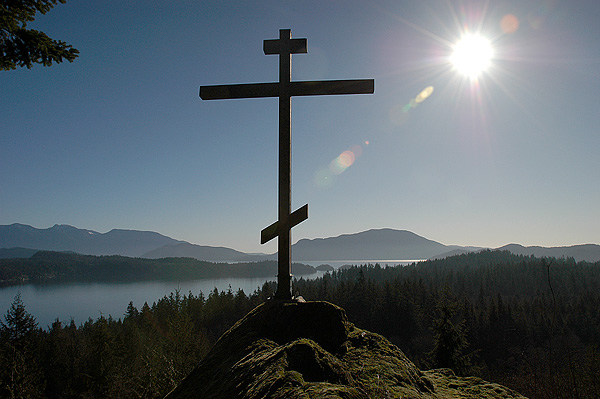


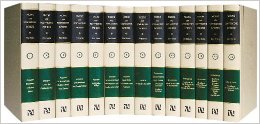
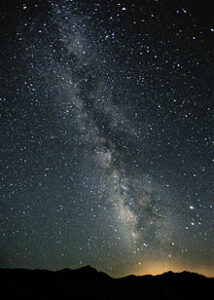
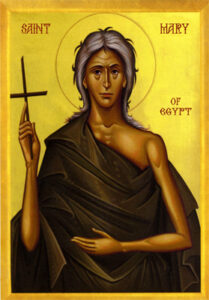
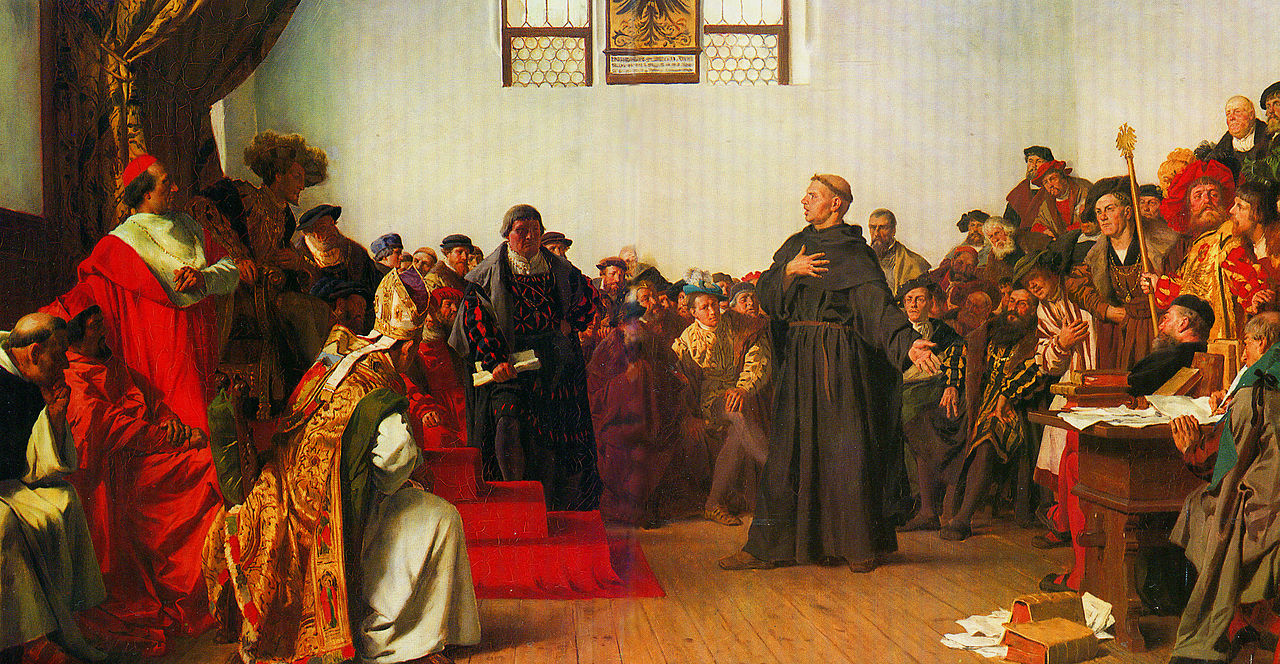
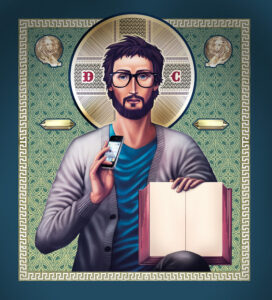


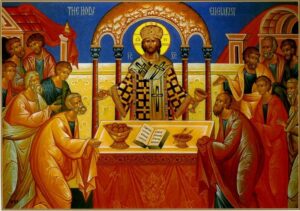
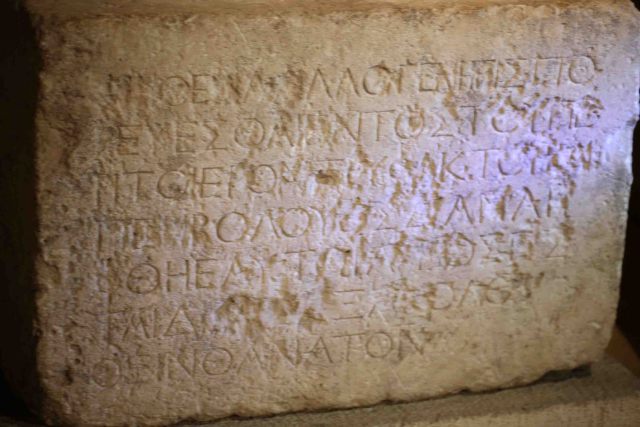
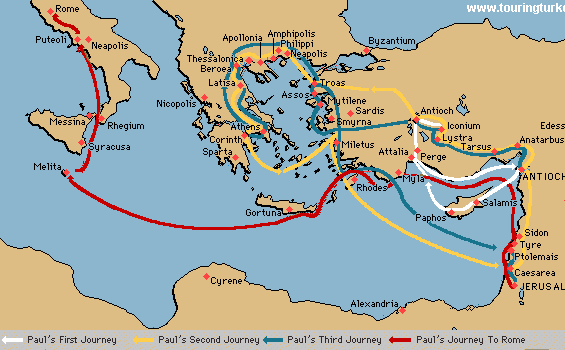
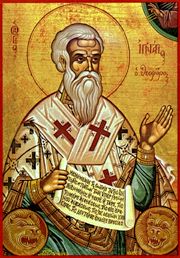
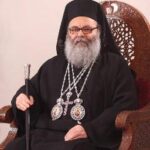

Recent Comments